
New terms are added every day, as international requirements evolve and new standards emerge,
One of the key terms in the pharmaceutical and food industries is MKT or Mean Kinetic Temperature.
This isa simplified way of expressing the overall effect of temperature variations during storage or transport of perishable goods. Consider the following, for example
for example:
Example:
A dozen eggs sitting:
In a room C 20 ° C for 2 hours
in a refrigerator at 2 ° C for 4 hours
and on a loading dock at 25°C for 1 hour
Using MKT, we can calculate thatthe temperature profile of the eggs is "thermally equivalent" to storing them at 10,096°C for 7 hours.
Technically speaking, MKT is an expression of the cumulative thermal stress experienced by a product at varying temperatures during storage and distribution. In other words, MKT is a single calculated temperature that is analogous to the effect of temperature variations over a period of time.
MKT is not a simple weighted average. The MKT calculation gives the highest temperatures greater weight when averaging than would a simple numerical or arithmetic average. This weighting is determined by a geometric transformation of the natural logarithm of the absolute temperature.
The International Conference on Harmonization (ICH) Stability Testing Guidelines define MKT as "a single derived temperature which, if maintained over a defined period, would give the same thermal challenge for a pharmaceutical product that would have been experienced over a range of two higher and lower temperatures for a defined equivalent period".
By using this unequal weighting profile of the highest temperatures in a temperature range, MKT takes into account the accelerated rate of thermal degradation of materials at these higher temperatures.
As a result, MKT predicts the non-linear effect of temperature.